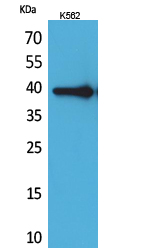HSP77/76 Polyclonal Antibody
- Catalog No.:YT5114
- Applications:WB;ELISA
- Reactivity:Human
- Target:
- HSP77/76
- Gene Name:
- HSPA6/HSPA7
- Protein Name:
- Heat shock 70 kDa protein 6/Putative heat shock 70 kDa protein 7
- Human Gene Id:
- 3310
- Human Swiss Prot No:
- P48741
- Immunogen:
- Synthesized peptide derived from the Internal region of human HSP77/76.
- Specificity:
- HSP77/76 Polyclonal Antibody detects endogenous levels of HSP77/76 protein.
- Formulation:
- Liquid in PBS containing 50% glycerol, 0.5% BSA and 0.02% sodium azide.
- Source:
- Polyclonal, Rabbit,IgG
- Dilution:
- WB 1:500 - 1:2000. ELISA: 1:20000. Not yet tested in other applications.
- Purification:
- The antibody was affinity-purified from rabbit antiserum by affinity-chromatography using epitope-specific immunogen.
- Concentration:
- 1 mg/ml
- Storage Stability:
- -15°C to -25°C/1 year(Do not lower than -25°C)
- Other Name:
- HSPA7;HSP70B;Putative heat shock 70 kDa protein 7;Heat shock 70 kDa protein B;HSPA6;HSP70B';Heat shock 70 kDa protein 6;Heat shock 70 kDa protein B'
- Observed Band(KD):
- 40kD
- Background:
- caution:Could be the product of a pseudogene.,function:In cooperation with other chaperones, Hsp70s stabilize preexistent proteins against aggregation and mediate the folding of newly translated polypeptides in the cytosol as well as within organelles. These chaperones participate in all these processes through their ability to recognize nonnative conformations of other proteins. They bind extended peptide segments with a net hydrophobic character exposed by polypeptides during translation and membrane translocation, or following stress-induced damage.,induction:Only at higher temperatures, and no basal expression.,similarity:Belongs to the heat shock protein 70 family.,
- Function:
- caution:Could be the product of a pseudogene.,function:In cooperation with other chaperones, Hsp70s stabilize preexistent proteins against aggregation and mediate the folding of newly translated polypeptides in the cytosol as well as within organelles. These chaperones participate in all these processes through their ability to recognize nonnative conformations of other proteins. They bind extended peptide segments with a net hydrophobic character exposed by polypeptides during translation and membrane translocation, or following stress-induced damage.,induction:Only at higher temperatures, and no basal expression.,similarity:Belongs to the heat shock protein 70 family.,
- Subcellular Location:
- COP9 signalosome,extracellular exosome,blood microparticle,
- Expression:
- Cerebellum,Lung,Ovary,Skin,
- June 19-2018
- WESTERN IMMUNOBLOTTING PROTOCOL
- June 19-2018
- IMMUNOHISTOCHEMISTRY-PARAFFIN PROTOCOL
- June 19-2018
- IMMUNOFLUORESCENCE PROTOCOL
- September 08-2020
- FLOW-CYTOMEYRT-PROTOCOL
- May 20-2022
- Cell-Based ELISA│解您多样本WB检测之困扰
- July 13-2018
- CELL-BASED-ELISA-PROTOCOL-FOR-ACETYL-PROTEIN
- July 13-2018
- CELL-BASED-ELISA-PROTOCOL-FOR-PHOSPHO-PROTEIN
- July 13-2018
- Antibody-FAQs
- Products Images

- Western Blot analysis of K562 cells using HSP77/76 Polyclonal Antibody. Secondary antibody(catalog#:RS0002) was diluted at 1:20000



